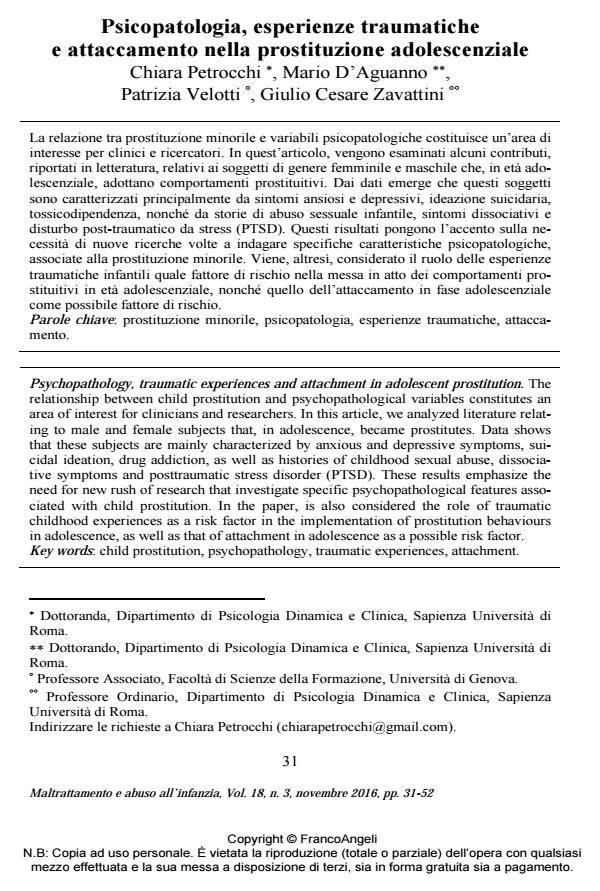Psychopathology, traumatic experiences and attachment in adolescent prostitution
Journal title MALTRATTAMENTO E ABUSO ALL’INFANZIA
Author/s Chiara Petrocchi, Mario D'Aguanno, Patrizia Velotti, Giulio Cesare Zavattini
Publishing Year 2017 Issue 2016/3
Language Italian Pages 22 P. 31-52 File size 246 KB
DOI 10.3280/MAL2016-003003
DOI is like a bar code for intellectual property: to have more infomation
click here
Below, you can see the article first page
If you want to buy this article in PDF format, you can do it, following the instructions to buy download credits

FrancoAngeli is member of Publishers International Linking Association, Inc (PILA), a not-for-profit association which run the CrossRef service enabling links to and from online scholarly content.
The relationship between child prostitution and psychopathological variables constitutes an area of interest for clinicians and researchers. In this article, we analyzed literature relating to male and female subjects that, in adolescence, became prostitutes. Data shows that these subjects are mainly characterized by anxious and depressive symptoms, suicidal ideation, drug addiction, as well as histories of childhood sexual abuse, dissociative symptoms and posttraumatic stress disorder (PTSD). These results emphasize the need for new rush of research that investigate specific psychopathological features associated with child prostitution. In the paper, is also considered the role of traumatic childhood experiences as a risk factor in the implementation of prostitution behaviours in adolescence, as well as that of attachment in adolescence as a possible risk factor.
Keywords: Child prostitution, psychopathology, traumatic experiences, attachment.
- “It’s also a kind of adrenalin competition” – selected aspects of the sex trade as viewed by clients Stanislav Ondrášek, Zuzana Řimnáčová, Alena Kajanová, in Human Affairs /2018 pp.24
DOI: 10.1515/humaff-2018-0003 - Trauma e sviluppo psichico: analisi di un caso di abuso sessuale Mirella Montemurro, in MALTRATTAMENTO E ABUSO ALL'INFANZIA 1/2018 pp.81
DOI: 10.3280/MAL2018-001006
Chiara Petrocchi, Mario D'Aguanno, Patrizia Velotti, Giulio Cesare Zavattini, Psicopatologia, esperienze traumatiche e attaccamento nella prostituzione adolescenziale in "MALTRATTAMENTO E ABUSO ALL’INFANZIA" 3/2016, pp 31-52, DOI: 10.3280/MAL2016-003003